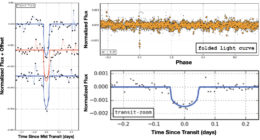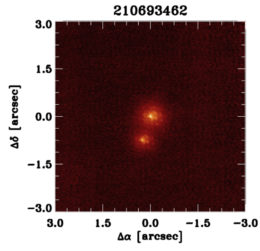In today’s era of big data, we often rely on computers to do sorting, searching, and analyzing. Sometimes, however, there’s just no substitute for the human eye and brain, which comes pre-loaded with excellent pattern-detection capabilities. This is where citizen science come in.
Managing Heaps of Data

Top: raw K2 photometry of K2-288. Spacecraft systematics must first be corrected before we have a chance of searching for planet transit signals! Bottom: the light curve after it has been corrected for systematics and detrended. Previously, systematics corrections had trimmed a transit off the front end of these observations, preventing automatic detection of the planet. Those data are included here, however. [Feinstein et al. 2019]
In the K2 mission, scientists used an automated search pipeline to check the light curves of tens of thousands of stars for transit candidates. Wisely, however, the K2 team didn’t dismiss the inconclusive light curves after this first automated pass.
Those curves with candidate transits that didn’t quite meet the algorithm’s thresholds were then passed to a citizen-science project known as Exoplanet Explorers, a Zooniverse spinoff. There, citizen scientists had the opportunity to examine individual candidate transit events and phase-folded light curves, hunting for features consistent with a transiting planet that the automated search may have missed.

The vetting diagnostics for K2-288 presented to citizen scientists on Exoplanet Explorers: a stack of individual transits (left), the full K2 light curve folded onto the candidate transit period (right top), and the zoom on the transit in the period-folded light curve (right bottom). [Feinstein et al. 2019]
Successful Discovery
Sixteen citizen scientists flagged the star K2-288 as showing signs of hosting a transiting planet. Upon further inspection, it was evident that this candidate had been missed by the automated search because the original data had been trimmed in order to remove systematics. This trimming had dropped one of the planet’s three observed transits; with only two possible transits visible, the automated search didn’t flag K2-288.
With access to reprocessed data, however, the Exoplanet Explorers citizen scientists identified K2-288 as a candidate of interest and passed it along to the waiting team of scientists. Led by Adina Feinstein (Tufts University and University of Chicago), that team then conducted follow-up observations of K2-288 to confirm the presence of a planet and determine its properties.
An Unusual World
Feinstein and collaborators report that the confirmed planet, K2-288Bb, is a small (~1.9 Earth radii) planet that lies in or near the habitable zone of its host — a host that is one of two M-dwarf stars in a binary system.

An example follow-up image of K2-288, taken with Keck/NIRC2 adaptive optics. The two stars of the binary system are evident. [Adapted from Feinstein et al. 2019]
Additionally, K2-288Bb’s estimated radius places it in an observed gap in planet radius distribution. Its unusual size suggests that its atmosphere may be evolving, causing it to transition either from gaseous mini-Neptune to rocky super-Earth or the other way around.
More observations of this intriguing system will help us to better understand what we’re seeing. In the meantime, we can be glad for citizen scientists helping us to spot what automated techniques might miss!
Citation
“K2-288Bb: A Small Temperate Planet in a Low-mass Binary System Discovered by Citizen Scientists,” Adina D. Feinstein et al 2019 AJ 157 40. doi:10.3847/1538-3881/aafa70

2 Comments
Pingback: AAS Nova – New
Pingback: Daily Study Log (2019-02-08) | Study Astrophysics